Anastasios Kyrillidis
One Rank at a Time: Cascading Error Dynamics in Sequential Learning
May 28, 2025Abstract:Sequential learning -- where complex tasks are broken down into simpler, hierarchical components -- has emerged as a paradigm in AI. This paper views sequential learning through the lens of low-rank linear regression, focusing specifically on how errors propagate when learning rank-1 subspaces sequentially. We present an analysis framework that decomposes the learning process into a series of rank-1 estimation problems, where each subsequent estimation depends on the accuracy of previous steps. Our contribution is a characterization of the error propagation in this sequential process, establishing bounds on how errors -- e.g., due to limited computational budgets and finite precision -- affect the overall model accuracy. We prove that these errors compound in predictable ways, with implications for both algorithmic design and stability guarantees.
Exploring How LLMs Capture and Represent Domain-Specific Knowledge
Apr 24, 2025Abstract:We study whether Large Language Models (LLMs) inherently capture domain-specific nuances in natural language. Our experiments probe the domain sensitivity of LLMs by examining their ability to distinguish queries from different domains using hidden states generated during the prefill phase. We reveal latent domain-related trajectories that indicate the model's internal recognition of query domains. We also study the robustness of these domain representations to variations in prompt styles and sources. Our approach leverages these representations for model selection, mapping the LLM that best matches the domain trace of the input query (i.e., the model with the highest performance on similar traces). Our findings show that LLMs can differentiate queries for related domains, and that the fine-tuned model is not always the most accurate. Unlike previous work, our interpretations apply to both closed and open-ended generative tasks
Quantum EigenGame for excited state calculation
Mar 17, 2025



Abstract:Computing the excited states of a given Hamiltonian is computationally hard for large systems, but methods that do so using quantum computers scale tractably. This problem is equivalent to the PCA problem where we are interested in decomposing a matrix into a collection of principal components. Classically, PCA is a well-studied problem setting, for which both centralized and distributed approaches have been developed. On the distributed side, one recent approach is that of EigenGame, a game-theoretic approach to finding eigenvectors where each eigenvector reaches a Nash equilibrium either sequentially or in parallel. With this work, we extend the EigenGame algorithm for both a $0^\text{th}$-order approach and for quantum computers, and harness the framework that quantum computing provides in computing excited states. Results show that using the Quantum EigenGame allows us to converge to excited states of a given Hamiltonian without the need of a deflation step. We also develop theory on error accumulation for finite-differences and parameterized approaches.
Unveiling Hidden Pivotal Players with GoalNet: A GNN-Based Soccer Player Evaluation System
Mar 12, 2025Abstract:Soccer analysis tools emphasize metrics such as expected goals, leading to an overrepresentation of attacking players' contributions and overlooking players who facilitate ball control and link attacks. Examples include Rodri from Manchester City and Palhinha who just transferred to Bayern Munich. To address this bias, we aim to identify players with pivotal roles in a soccer team, incorporating both spatial and temporal features. In this work, we introduce a GNN-based framework that assigns individual credit for changes in expected threat (xT), thus capturing overlooked yet vital contributions in soccer. Our pipeline encodes both spatial and temporal features in event-centric graphs, enabling fair attribution of non-scoring actions such as defensive or transitional plays. We incorporate centrality measures into the learned player embeddings, ensuring that ball-retaining defenders and defensive midfielders receive due recognition for their overall impact. Furthermore, we explore diverse GNN variants-including Graph Attention Networks and Transformer-based models-to handle long-range dependencies and evolving match contexts, discussing their relative performance and computational complexity. Experiments on real match data confirm the robustness of our approach in highlighting pivotal roles that traditional attacking metrics typically miss, underscoring the model's utility for more comprehensive soccer analytics.
Provable Model-Parallel Distributed Principal Component Analysis with Parallel Deflation
Feb 24, 2025Abstract:We study a distributed Principal Component Analysis (PCA) framework where each worker targets a distinct eigenvector and refines its solution by updating from intermediate solutions provided by peers deemed as "superior". Drawing intuition from the deflation method in centralized eigenvalue problems, our approach breaks the sequential dependency in the deflation steps and allows asynchronous updates of workers, while incurring only a small communication cost. To our knowledge, a gap in the literature -- the theoretical underpinning of such distributed, dynamic interactions among workers -- has remained unaddressed. This paper offers a theoretical analysis explaining why, how, and when these intermediate, hierarchical updates lead to practical and provable convergence in distributed environments. Despite being a theoretical work, our prototype implementation demonstrates that such a distributed PCA algorithm converges effectively and in scalable way: through experiments, our proposed framework offers comparable performance to EigenGame-$\mu$, the state-of-the-art model-parallel PCA solver.
A Catalyst Framework for the Quantum Linear System Problem via the Proximal Point Algorithm
Jun 19, 2024Abstract:Solving systems of linear equations is a fundamental problem, but it can be computationally intensive for classical algorithms in high dimensions. Existing quantum algorithms can achieve exponential speedups for the quantum linear system problem (QLSP) in terms of the problem dimension, but even such a theoretical advantage is bottlenecked by the condition number of the coefficient matrix. In this work, we propose a new quantum algorithm for QLSP inspired by the classical proximal point algorithm (PPA). Our proposed method can be viewed as a meta-algorithm that allows inverting a modified matrix via an existing \texttt{QLSP\_solver}, thereby directly approximating the solution vector instead of approximating the inverse of the coefficient matrix. By carefully choosing the step size $\eta$, the proposed algorithm can effectively precondition the linear system to mitigate the dependence on condition numbers that hindered the applicability of previous approaches.
Better Schedules for Low Precision Training of Deep Neural Networks
Mar 04, 2024Abstract:Low precision training can significantly reduce the computational overhead of training deep neural networks (DNNs). Though many such techniques exist, cyclic precision training (CPT), which dynamically adjusts precision throughout training according to a cyclic schedule, achieves particularly impressive improvements in training efficiency, while actually improving DNN performance. Existing CPT implementations take common learning rate schedules (e.g., cyclical cosine schedules) and use them for low precision training without adequate comparisons to alternative scheduling options. We define a diverse suite of CPT schedules and analyze their performance across a variety of DNN training regimes, some of which are unexplored in the low precision training literature (e.g., node classification with graph neural networks). From these experiments, we discover alternative CPT schedules that offer further improvements in training efficiency and model performance, as well as derive a set of best practices for choosing CPT schedules. Going further, we find that a correlation exists between model performance and training cost, and that changing the underlying CPT schedule can control the tradeoff between these two variables. To explain the direct correlation between model performance and training cost, we draw a connection between quantized training and critical learning periods, suggesting that aggressive quantization is a form of learning impairment that can permanently damage model performance.
* 20 pages, 8 figures, 1 table, ACML 2023
On the Error-Propagation of Inexact Deflation for Principal Component Analysis
Oct 06, 2023



Abstract:Principal Component Analysis (PCA) is a popular tool in data analysis, especially when the data is high-dimensional. PCA aims to find subspaces, spanned by the so-called \textit{principal components}, that best explain the variance in the dataset. The deflation method is a popular meta-algorithm -- used to discover such subspaces -- that sequentially finds individual principal components, starting from the most important one and working its way towards the less important ones. However, due to its sequential nature, the numerical error introduced by not estimating principal components exactly -- e.g., due to numerical approximations through this process -- propagates, as deflation proceeds. To the best of our knowledge, this is the first work that mathematically characterizes the error propagation of the inexact deflation method, and this is the key contribution of this paper. We provide two main results: $i)$ when the sub-routine for finding the leading eigenvector is generic, and $ii)$ when power iteration is used as the sub-routine. In the latter case, the additional directional information from power iteration allows us to obtain a tighter error bound than the analysis of the sub-routine agnostic case. As an outcome, we provide explicit characterization on how the error progresses and affects subsequent principal component estimations for this fundamental problem.
Sweeping Heterogeneity with Smart MoPs: Mixture of Prompts for LLM Task Adaptation
Oct 05, 2023



Abstract:Large Language Models (LLMs) have the ability to solve a variety of tasks, such as text summarization and mathematical questions, just out of the box, but they are often trained with a single task in mind. Due to high computational costs, the current trend is to use prompt instruction tuning to better adjust monolithic, pretrained LLMs for new -- but often individual -- downstream tasks. Thus, how one would expand prompt tuning to handle -- concomitantly -- heterogeneous tasks and data distributions is a widely open question. To address this gap, we suggest the use of \emph{Mixture of Prompts}, or MoPs, associated with smart gating functionality: the latter -- whose design is one of the contributions of this paper -- can identify relevant skills embedded in different groups of prompts and dynamically assign combined experts (i.e., collection of prompts), based on the target task. Additionally, MoPs are empirically agnostic to any model compression technique applied -- for efficiency reasons -- as well as instruction data source and task composition. In practice, MoPs can simultaneously mitigate prompt training "interference" in multi-task, multi-source scenarios (e.g., task and data heterogeneity across sources), as well as possible implications from model approximations. As a highlight, MoPs manage to decrease final perplexity from $\sim20\%$ up to $\sim70\%$, as compared to baselines, in the federated scenario, and from $\sim 3\%$ up to $\sim30\%$ in the centralized scenario.
CrysFormer: Protein Structure Prediction via 3d Patterson Maps and Partial Structure Attention
Oct 05, 2023



Abstract:Determining the structure of a protein has been a decades-long open question. A protein's three-dimensional structure often poses nontrivial computation costs, when classical simulation algorithms are utilized. Advances in the transformer neural network architecture -- such as AlphaFold2 -- achieve significant improvements for this problem, by learning from a large dataset of sequence information and corresponding protein structures. Yet, such methods only focus on sequence information; other available prior knowledge, such as protein crystallography and partial structure of amino acids, could be potentially utilized. To the best of our knowledge, we propose the first transformer-based model that directly utilizes protein crystallography and partial structure information to predict the electron density maps of proteins. Via two new datasets of peptide fragments (2-residue and 15-residue) , we demonstrate our method, dubbed \texttt{CrysFormer}, can achieve accurate predictions, based on a much smaller dataset size and with reduced computation costs.
 Add to Chrome
Add to Chrome Add to Firefox
Add to Firefox Add to Edge
Add to Edge